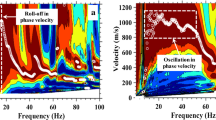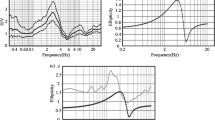Abstract
Identifying correct modes of surface waves and picking accurate phase velocities are critical for obtaining an accurate S-wave velocity in MASW method. In most cases, inversion is easily conducted by picking the dispersion curves corresponding to different surface-wave modes individually. Neighboring surface-wave modes, however, will nearly meet (kiss) at some frequencies for some models. Around the frequencies, they have very close roots and energy peak shifts from one mode to another. At current dispersion image resolution, it is difficult to distinguish different modes when mode-kissing occurs, which is commonly seen in near-surface earth models. It will cause mode misidentification, and as a result, lead to a larger overestimation of S-wave velocity and error on depth. We newly defined two mode types based on the characteristics of the vertical eigendisplacements calculated by generalized reflection and transmission coefficient method. Rayleigh-wave mode near the kissing points (osculation points) change its type, that is to say, one Rayleigh-wave mode will contain different mode types. This mode type conversion will cause the mode-kissing phenomenon in dispersion images. Numerical tests indicate that the mode-kissing phenomenon is model dependent and that the existence of strong S-wave velocity contrasts increases the possibility of mode-kissing. The real-world data shows mode misidentification caused by mode-kissing phenomenon will result in higher S-wave velocity of bedrock. It reminds us to pay attention to this phenomenon when some of the underground information is known.











Similar content being viewed by others
References
Chen, X., 1993, A systematic and efficient method of computing normal modes for multilayered half-space. Geophysical Journal International, 115, 391–409.
Gao, L., Xia, J., Pan, Y., 2014, Misidentification caused by leaky surface wave in high-frequency surface wave method. Geophysical Journal International, 199, 1452–1462.
Ivanov, J., Miller, R.D., Xia J., Steeples, D.W., Park C.B., 2006. Joint analysis of refractions with surface waves: an inverse solution to the refraction-traveltime problem. Geophysics, 71(6): R131–R138.
Lu, L., Wang, C., Zhang, B., 2007. Inversion of multimode Rayleigh waves in the presence of a low-velocity layer: numerical and laboratory study. Geophysical Journal International, 168, 1235–1246.
Luo, Y., Xia, J., Liu, J., Liu, Q., Xu, S., 2007. Joint inversion of high-frequency surface waves with fundamental and higher modes. Journal of Applied Geophysics, 62(4): 375–384.
Luo, Y., Xia, J., Miller, R.D., Xu, Y., Liu, J., Liu, Q., 2008. Rayleigh-wave dispersive energy imaging by high-resolution linear Radon transform: Pure and Applied Geophysics, 165(5), 903–922.
Luo, Y., Xia, J., Xu, Y., Zeng, C., Liu, J., 2010. Finite-difference modeling and dispersion analysis of high-frequency Love waves for near-surface applications: Pure and Applied Geophysics, 167(12), 1525–1536.
Maraschini, M., Ernst, F., Foti, S., Socco, L.V., 2010. A new misfit function for multimodal inversion of surface waves. Geophysics, 75(4), G31–G43.
Socco, L.V., Foti, S., Boiero, D., 2010. Surface wave analysis for building near surface velocity models: established approaches and new perspectives. Geophysics, 75: A83–A102.
Xia, J., Miller, R.D., Park, C.B., 1999. Estimation of near-surface shear-wave velocity by inversion of Rayleigh wave. Geophysics, 64(3): 691–700.
Xia, J., Miller, R.D., Park, C.B., Tian, G., 2003. Inversion of high frequency surface waves with fundamental and higher modes. Journal of Applied Geophysics, 52(1): 45–57.
Xia, J., Xu, Y., Chen, C., et al., 2006. Simple equations guide high-frequency surface-wave investigation techniques. Soil Dynamics and Earthquake Engineering, 26(5): 395–403.
Xia, J., Xu, Y., and Luo, Y., 2012. Advantage of using multichannel analysis of Love waves (MALW) to estimate near-surface shear-wave velocity. Survey in Geophysics, 33, 841–860.
Xu, Y., Xia, J., Miller, R.D., 2009. Approximation to cutoffs of higher modes of Rayleigh waves for a layered earth model: Pure and Applied Geophysics, 166, 339–351.
Zeng, C., Xia, J., Miller, R.D., Tsoflias, G.P., 2011. Application of the multiaxial perfectly matched layer (M-PML) to near-surface seismic modeling with Rayleigh waves. Geophysics 76 (3), T43–T52.
Zhang, S., Chan, L., 2003. Possible effects of misidentified mode number on Rayleigh wave inversion. Journal of Applied Geophysics, 53, 17–29.
Acknowledgments
The authors would like to thank Editor Lupei Zhu, two anonymous reviewers for their constructive comments and suggestions. The second author would also like to thank John Bradford and his colleague for assistance in acquisition of the data used in this paper at BHRS. This research is supported by the National Natural Science Foundation of China (NSFC), under Grant No. 41274142.
Author information
Authors and Affiliations
Corresponding author
Rights and permissions
About this article
Cite this article
Gao, L., Xia, J., Pan, Y. et al. Reason and Condition for Mode Kissing in MASW Method. Pure Appl. Geophys. 173, 1627–1638 (2016). https://doi.org/10.1007/s00024-015-1208-5
Received:
Revised:
Accepted:
Published:
Issue Date:
DOI: https://doi.org/10.1007/s00024-015-1208-5




